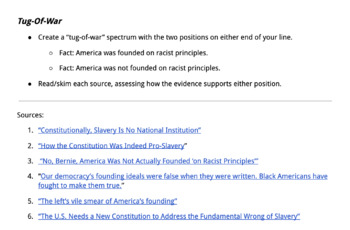"Racist Principles" Tug-Of-War
Maya Suzuki Daniels
2 Followers
Grade Levels
11th - 12th, Higher Education, Adult Education, Staff
Resource Type
Standards
CCSSRI.11-12.1
CCSSRI.11-12.5
CCSSRI.11-12.7
CCSSRI.11-12.8
CCSSRI.11-12.9
Formats Included
- Google Docs™
Maya Suzuki Daniels
2 Followers

Made for Google Drive™
This resource can be used by students on Google Drive or Google Classroom. To access this resource, you’ll need to allow TPT to add it to your Google Drive. See our FAQ and Privacy Policy for more information.
Description
In 2015, Bernie Sanders set the internet abuzz when he declared that the U.S. "was, in fact, based on racist principles." The New York Times put out an Op-Ed declaring that the Constitution was not pro-slavery, prompting a response from the Atlantic asserting the opposite. In this activity, students identify and evaluate evidence based on various perspectives. Beyond seeing how different "facts" can be supported by historical evidence and readings, students practice critical thinking in assessing the interpretation of facts themselves.
Total Pages
Answer Key
N/A
Teaching Duration
N/A
Last updated Sep 26th, 2021
Report this resource to TPT
Reported resources will be reviewed by our team. Report this resource to let us know if this resource violates TPT’s content guidelines.
Standards
to see state-specific standards (only available in the US).
CCSSRI.11-12.1
Cite strong and thorough textual evidence to support analysis of what the text says explicitly as well as inferences drawn from the text, including determining where the text leaves matters uncertain.
CCSSRI.11-12.5
Analyze and evaluate the effectiveness of the structure an author uses in his or her exposition or argument, including whether the structure makes points clear, convincing, and engaging.
CCSSRI.11-12.7
Integrate and evaluate multiple sources of information presented in different media or formats (e.g., visually, quantitatively) as well as in words in order to address a question or solve a problem.
CCSSRI.11-12.8
Delineate and evaluate the reasoning in seminal U.S. texts, including the application of constitutional principles and use of legal reasoning (e.g., in U.S. Supreme Court majority opinions and dissents) and the premises, purposes, and arguments in works of public advocacy (e.g., The Federalist, presidential addresses).
CCSSRI.11-12.9
Analyze seventeenth-, eighteenth-, and nineteenth-century foundational U.S. documents of historical and literary significance (including The Declaration of Independence, the Preamble to the Constitution, the Bill of Rights, and Lincoln’s Second Inaugural Address) for their themes, purposes, and rhetorical features.


